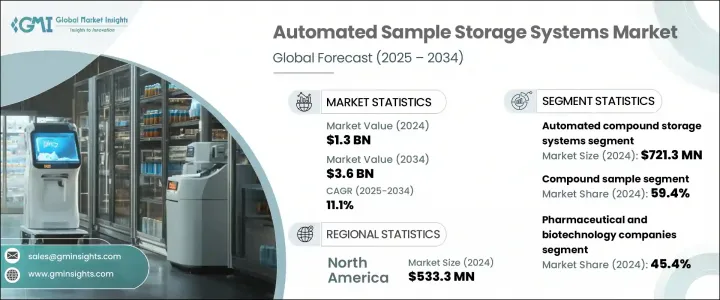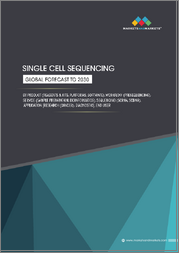
|
시장보고서
상품코드
1797814
세계의 자동 샘플 보관 시스템 시장 : 기회, 성장 촉진요인, 산업 동향 분석, 예측(2025-2034년)Automated Sample Storage Systems Market Opportunity, Growth Drivers, Industry Trend Analysis, and Forecast 2025 - 2034 |
||||||
세계의 자동 샘플 보관 시스템 시장은 2024년 13억 달러로 평가되었으며 CAGR 11.1%로 성장해 2034년까지 36억 달러에 이를 것으로 추정됩니다.
이 강력한 성장 궤도는 바이오리포지토리에 대한 수요가 증가하고, 시료의 무결성 유지에 대한 주목 증가, 생명 과학 및 임상 실험실 내의 디지털 변혁이 원동력이 되고 있습니다. 의약품 개발과 유전체 연구가 진행됨에 따라 세계 실험실은 보다 정확하고 안전하며 확장 가능한 시료 관리를 위해 자동화를 목표로 하고 있습니다. 자동 보관 시스템과 실험실 정보 관리 시스템(LIMS)과 같은 실험실 디지털화 도구의 통합은 샘플 추적, 재고 관리, 데이터의 정확성을 향상시킵니다.

대규모 연구 프로그램과 공중 보건 바이오 뱅크에 대한 투자 증가는 확장 가능하고 기술 중심의 저장 솔루션의 필요성을 부추기고 있습니다. 자동화된 시스템은 특히 제약, 생명공학, 임상 현장에서 인위적인 실수를 줄이고, 컴플라이언스를 유지하며, 높은 처리량 워크플로우를 지원합니다. 시료량과 데이터의 복잡성이 증가함에 따라 자동화는 효율적인 실험실 운영의 기초가 되고 있으며, 최신 실험실 인프라와 임상 연구 환경의 미래를 형성하고 있습니다.
| 시장 범위 | |
|---|---|
| 시작 연도 | 2024년 |
| 예측 연도 | 2025-2034년 |
| 시작 금액 | 13억 달러 |
| 예측 금액 | 36억 달러 |
| CAGR | 11.1% |
2024년 화합물 자동 보관 시스템 분야의 매출은 7억 2,130만 달러였습니다. 이러한 시스템은 대규모 화합물 라이브러리를 최소한의 수동으로 보관할 수 있게 함으로써 창약에 중요한 역할을 합니다. 화합물의 검색을 합리화하고 일관성을 확보하는 능력에 의해 창약 스크리닝의 워크플로우나 의약품 연구개발 업무에 불가결한 것이 되고 있습니다. 화합물 라이브러리의 크기가 증가하고 높은 처리량 환경에서 재현성이 높은 결과가 요구되고 있기 때문에 안정적인 화합물 관리에 대한 요구가 계속 증가하고 있습니다.
화합물 시료 부문은 2024년에 59.4%의 점유율을 차지하며, 속도가 빠른 스크리닝 환경에서의 용도 증가가 견인하고 있습니다. 제약 회사가 빠른 납기를 요구하는 동안 정확한 추적, 온도 관리 및 로봇 취급을 제공하는 자동화 솔루션은 화합물 스크리닝 워크플로우를 강화하고 궁극적으로 타임라인을 단축하여 창약 효율을 향상시키는 데 도움이 됩니다.
미국의 자동 샘플 보관 시스템 시장은 2024년 4억 7,250만 달러를 창출해 주요 지역 공헌 기업으로서의 지위를 굳혔습니다. 북미의 리더십은 시료 보관의 자동화를 적극적으로 이용하는 제약 기업과 생명 공학 기업의 존재감의 강도에 기인하고 있습니다. 이 지역은 또한 연구 프로그램에 대응하는 주요 바이오 뱅크 시설을 보유하고 있으며 확장 가능하고 안전한 시료 관리 시스템에 대한 수요를 더욱 밀어 올리고 있습니다. 현재 진행 중인 창약 파이프라인의 확대와 정밀의료의 추진도 이 지역에서의 고급 보관 솔루션의 채용을 뒷받침하고 있습니다.
세계의 자동 샘플 보관 시스템 시장을 형성하는 주요 기업은 Thermo Fisher Scientific, Brooks Automation, MEGAROBO, ASKION, Panasonic Healthcare, TTP LabTech, Biotron Healthcare, SPT Labtech, Beckman Coulter, Haier Biomedical, Angelantoni Life Science, LiCONiC, Azenta, Hamilton Company, MICRONIC 등이 있습니다. 자동 샘플 보관 시스템 시장의 주요 기업은 기술 통합 강화, 세계 판매 채널 확대, 진화하는 고객 요구에 맞는 시스템 개발에 주력하고 있습니다. 그 중 다수는 차세대 로봇 엔지니어링, AI 기반 샘플 추적, 실험실 정보 플랫폼과 원활하게 연결하기 위한 클라우드 기반 소프트웨어에 투자하고 있습니다. 각 회사는 또한 전략적 파트너십과 인수를 통해 특히 신흥 바이오 의약품 기지에서 지역적 존재를 강화하고 있습니다.
목차
제1장 조사 방법과 범위
제2장 주요 요약
제3장 업계 인사이트
- 생태계 분석
- 공급자의 상황
- 밸류체인에 영향을 주는 요인
- 업계에 미치는 영향요인
- 성장 촉진요인
- 바이오뱅킹과 바이오리포지토리의 유지에 대한 요구 증가
- 임상 및 조사 실험실 전체의 디지털 변혁
- 의약품의 발견과 개발의 성장
- 시료의 무결성과 컴플라이언스에 대한 주목 상승
- 업계의 잠재적 위험 및 과제
- 다액의 초기 자본 투자의 필요성
- 데이터 보안 및 백업에 대한 우려
- 시장 기회
- AI와 IoT의 기술 진보
- 번들 원 스톱 솔루션 수요 증가
- 성장 촉진요인
- 성장 가능성 분석
- 규제 상황
- 기술과 혁신의 상황
- 현재의 기술 동향
- 신흥기술
- 미래 시장 동향
- 특허 분석
- 가격 분석
- 제품별
- 지역별
- 갭 분석
- Porter's Five Forces 분석
- PESTLE 분석
제4장 경쟁 구도
- 소개
- 기업의 시장 점유율 분석
- 기업 매트릭스 분석
- 주요 시장 기업의 경쟁 분석
- 경쟁 포지셔닝 매트릭스
- 주요 발전
- 합병 및 인수
- 파트너십 및 협업
- 신제품 발매
- 확장 계획
제5장 시장 추계 및 예측 : 제품별, 2021-2034년
- 주요 동향
- 자동 복합 보관 시스템
- 자동 액체 처리 시스템
- 기타 제품
제6장 시장 추계 및 예측 : 시료별, 2021-2034년
- 주요 동향
- 복합 시료
- 생물학적 시료
- 기타 시료
제7장 시장 추계 및 예측 : 최종 용도별, 2021-2034년
- 주요 동향
- 제약 및 생명 공학 기업
- 학술연구기관
- 바이오뱅크
- 기타 용도
제8장 시장 추계 및 예측 : 지역별, 2021-2034년
- 주요 동향
- 북미
- 미국
- 캐나다
- 유럽
- 독일
- 영국
- 프랑스
- 이탈리아
- 스페인
- 네덜란드
- 아시아태평양
- 중국
- 일본
- 인도
- 호주
- 한국
- 라틴아메리카
- 브라질
- 멕시코
- 아르헨티나
- 중동 및 아프리카
- 남아프리카
- 사우디아라비아
- 아랍에미리트(UAE)
제9장 기업 프로파일
- Angelantoni Life Science
- ASKION
- Azenta US
- Beckman Coulter
- Biotron Healthcare
- Brooks Automation
- Haier Biomedical
- Hamilton Company
- LiCONiC
- MEGAROBO
- MICRONIC
- Panasonic Healthcare
- SPT Labtech
- Thermo Fisher Scientific
- TTP LabTech
The Global Automated Sample Storage Systems Market was valued at USD 1.3 billion in 2024 and is estimated to grow at a CAGR of 11.1% to reach USD 3.6 billion by 2034. This strong growth trajectory is driven by the rising demand for biorepositories, increased focus on preserving sample integrity, and digital transformation within life science and clinical laboratories. As drug development and genomic research advance, laboratories across the globe are turning to automation for more accurate, secure, and scalable sample management. The integration of automated storage systems with lab digitization tools, such as laboratory information management systems (LIMS), enhances sample tracking, inventory control, and data accuracy.

The growing investment in large-scale research programs and public health biobanks is fueling the need for scalable, tech-driven storage solutions. Automated systems help labs reduce human error, maintain compliance, and support high-throughput workflows, especially in pharmaceutical, biotech, and clinical settings. As sample volumes and data complexity rise, automation is becoming a cornerstone of efficient lab operations, shaping the future of modern laboratory infrastructure and clinical research environments.
| Market Scope | |
|---|---|
| Start Year | 2024 |
| Forecast Year | 2025-2034 |
| Start Value | $1.3 Billion |
| Forecast Value | $3.6 Billion |
| CAGR | 11.1% |
In 2024, the automated compound storage systems segment generated USD 721.3 million. These systems play a critical role in pharmaceutical discovery by enabling large-scale chemical library storage with minimal manual intervention. Their ability to streamline compound retrieval and ensure consistency makes them vital to drug screening workflows and pharmaceutical R&D operations. The need for reliable compound management continues to grow due to increasing chemical library sizes and demand for reproducible results in high-throughput environments.
The compound sample segment held a 59.4% share in 2024, driven by rising applications in fast-paced screening environments. As pharmaceutical companies seek faster turnaround times, automated solutions offering precise tracking, temperature control, and robotic handling help enhance compound screening workflows, ultimately reducing timelines and improving efficiency in drug discovery.
U.S. Automated Sample Storage Systems Market generated USD 472.5 million in 2024, solidifying its position as a key regional contributor. North America's leadership stems from a strong presence of pharmaceutical and biotech companies actively using automation in sample storage. The region also hosts major biobank facilities that serve research programs, further boosting demand for scalable and secure sample management systems. The ongoing expansion of drug discovery pipelines and the push for precision medicine are also driving regional adoption of advanced storage solutions.
Leading players shaping the Global Automated Sample Storage Systems Market include Thermo Fisher Scientific, Brooks Automation, MEGAROBO, ASKION, Panasonic Healthcare, TTP LabTech, Biotron Healthcare, SPT Labtech, Beckman Coulter, Haier Biomedical, Angelantoni Life Science, LiCONiC, Azenta, Hamilton Company, and MICRONIC. Key companies in the automated sample storage systems market are focusing heavily on enhancing technology integration, expanding global distribution channels, and developing systems tailored to evolving customer needs. Many are investing in next-gen robotics, AI-based sample tracking, and cloud-based software for seamless connectivity with lab informatics platforms. Companies are also strengthening their regional presence through strategic partnerships and acquisitions, particularly in emerging biopharma hubs.
Table of Contents
Chapter 1 Methodology and Scope
- 1.1 Market scope and definition
- 1.2 Research design
- 1.2.1 Research approach
- 1.2.2 Data collection methods
- 1.3 Data mining sources
- 1.3.1 Global
- 1.3.2 Regional/Country
- 1.4 Base estimates and calculations
- 1.4.1 Base year calculation
- 1.4.2 Key trends for market estimation
- 1.5 Primary research and validation
- 1.5.1 Primary sources
- 1.6 Forecast model
- 1.7 Research assumptions and limitations
Chapter 2 Executive Summary
- 2.1 Industry 3600 synopsis
- 2.2 Key market trends
- 2.2.1 Regional
- 2.2.2 Product
- 2.2.3 Sample
- 2.2.4 End use
- 2.3 CXO perspectives: Strategic imperatives
- 2.3.1 Key decision points for industry executives
- 2.3.2 Critical success factors for market players
- 2.4 Future outlook and strategic recommendations
Chapter 3 Industry Insights
- 3.1 Industry ecosystem analysis
- 3.1.1 Supplier landscape
- 3.1.2 Factor affecting the value chain
- 3.2 Industry impact forces
- 3.2.1 Growth drivers
- 3.2.1.1 Growing need for biobanking and maintaining biorepositories
- 3.2.1.2 Digital transformation across clinical and research laboratories
- 3.2.1.3 Growth in drug discovery and development
- 3.2.1.4 Growing focus on sample integrity and compliance
- 3.2.2 Industry pitfalls and challenges
- 3.2.2.1 Requirement of substantial initial capital investments
- 3.2.2.2 Concerns related to data security and backup
- 3.2.3 Market opportunities
- 3.2.3.1 Technological advancements in AI and IoT
- 3.2.3.2 Growing demand for bundled one-stop solutions
- 3.2.1 Growth drivers
- 3.3 Growth potential analysis
- 3.4 Regulatory landscape
- 3.4.1 North America
- 3.4.2 Europe
- 3.4.3 Asia Pacific
- 3.4.4 Latin America
- 3.4.5 Middle East and Africa
- 3.5 Technology and innovation landscape
- 3.5.1 Current technological trends
- 3.5.2 Emerging technologies
- 3.6 Future market trends
- 3.7 Patent analysis
- 3.8 Pricing analysis
- 3.8.1 By product
- 3.8.2 By region
- 3.9 Gap analysis
- 3.10 Porter's analysis
- 3.11 PESTLE analysis
Chapter 4 Competitive Landscape, 2024
- 4.1 Introduction
- 4.2 Company market share analysis
- 4.3 Company matrix analysis
- 4.4 Competitive analysis of major market players
- 4.5 Competitive positioning matrix
- 4.6 Key developments
- 4.6.1 Mergers and acquisitions
- 4.6.2 Partnerships and collaborations
- 4.6.3 New product launches
- 4.6.4 Expansion plans
Chapter 5 Market Estimates and Forecast, By Product, 2021 - 2034 ($ Mn)
- 5.1 Key trends
- 5.2 Automated compound storage systems
- 5.3 Automated liquid handling systems
- 5.4 Other products
Chapter 6 Market Estimates and Forecast, By Sample, 2021 - 2034 ($ Mn)
- 6.1 Key trends
- 6.2 Compound sample
- 6.3 Biological sample
- 6.4 Other samples
Chapter 7 Market Estimates and Forecast, By End Use, 2021 - 2034 ($ Mn)
- 7.1 Key trends
- 7.2 Pharmaceutical and biotechnology companies
- 7.3 Academic and research institutes
- 7.4 Biobanks
- 7.5 Other end use
Chapter 8 Market Estimates and Forecast, By Region, 2021 - 2034 ($ Mn)
- 8.1 Key trends
- 8.2 North America
- 8.2.1 U.S.
- 8.2.2 Canada
- 8.3 Europe
- 8.3.1 Germany
- 8.3.2 UK
- 8.3.3 France
- 8.3.4 Italy
- 8.3.5 Spain
- 8.3.6 Netherlands
- 8.4 Asia Pacific
- 8.4.1 China
- 8.4.2 Japan
- 8.4.3 India
- 8.4.4 Australia
- 8.4.5 South Korea
- 8.5 Latin America
- 8.5.1 Brazil
- 8.5.2 Mexico
- 8.5.3 Argentina
- 8.6 Middle East and Africa
- 8.6.1 South Africa
- 8.6.2 Saudi Arabia
- 8.6.3 UAE
Chapter 9 Company Profile
- 9.1 Angelantoni Life Science
- 9.2 ASKION
- 9.3 Azenta US
- 9.4 Beckman Coulter
- 9.5 Biotron Healthcare
- 9.6 Brooks Automation
- 9.7 Haier Biomedical
- 9.8 Hamilton Company
- 9.9 LiCONiC
- 9.10 MEGAROBO
- 9.11 MICRONIC
- 9.12 Panasonic Healthcare
- 9.13 SPT Labtech
- 9.14 Thermo Fisher Scientific
- 9.15 TTP LabTech



















